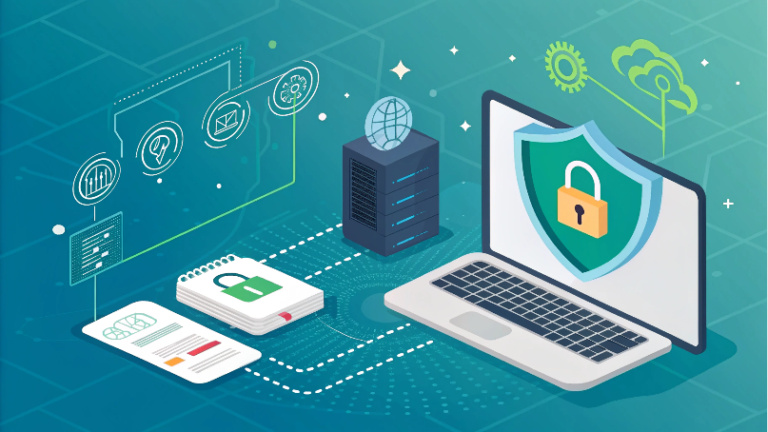Top Cybersecurity Practices for Small Businesses
In today’s digital landscape, small businesses are increasingly becoming targets for cybercriminals. Contrary to popular belief, hackers don’t just go after large corporations; small businesses often have fewer defenses, making them easier prey. Implementing the top cybersecurity practices for small businesses is no longer optional—it’s a necessity for survival.
With the rising incidents of ransomware, phishing, and data breaches, small business owners must take proactive steps to secure their digital assets, protect customer data, and ensure the continuity of operations. This guide outlines the most critical cybersecurity practices every small business should adopt.
Conduct a Cybersecurity Risk Assessment
Before you can defend your systems, you need to understand where your vulnerabilities lie.
Key Actions:
- Identify and categorize your assets (e.g., financial data, customer records, employee data).
- Assess current security measures and policies.
- Evaluate the potential impact of different types of cyber threats.
A risk assessment helps you prioritize your cybersecurity efforts based on your greatest risks.
Use Strong, Unique Passwords and Enable Multi-Factor Authentication
Passwords remain a primary defense against unauthorized access. Weak or reused passwords make your systems vulnerable.
Best Practices:
- Use complex passwords with a mix of letters, numbers, and symbols.
- Avoid using the same password across multiple platforms.
- Implement multi-factor authentication (MFA) wherever possible to add a second layer of protection.
Password managers can help your team store and generate strong passwords without memorization struggles.
Regularly Update Software and Systems
Outdated software often contains known security vulnerabilities that hackers exploit.
What You Should Do:
- Enable automatic updates for all critical systems and applications.
- Regularly update your operating systems, antivirus software, and firewalls.
- Replace obsolete hardware or software that is no longer supported by vendors.
Timely updates close security loopholes and improve the resilience of your systems.
Train Employees on Cybersecurity Awareness
Employees are often the weakest link in a company’s cybersecurity chain, usually due to lack of awareness.
Training Topics to Cover:
- Recognizing phishing emails and suspicious links.
- Safe internet and email usage.
- Reporting security incidents promptly.
- Handling sensitive customer data securely.
Regular training sessions and simulated phishing tests can keep security top of mind.
Secure Your Wi-Fi Networks
Unsecured Wi-Fi networks can be an open door for cybercriminals.
Network Security Measures:
- Change the default router login credentials.
- Use strong WPA3 encryption.
- Hide your SSID (network name) if it’s not meant for public use.
- Create a separate guest network for visitors.
By locking down your Wi-Fi, you reduce the chances of unauthorized access.
Perform Regular Data Backups
Data loss due to a cyberattack or system failure can be devastating, especially for small businesses.
Backup Strategies:
- Follow the 3-2-1 rule: 3 copies of your data, on 2 different media, with 1 off-site.
- Automate your backups to ensure they’re always up to date.
- Periodically test backups to make sure they work.
Having recent, reliable backups can be a lifesaver in case of ransomware or accidental deletion.
Install and Maintain Antivirus and Firewall Protection
Antivirus and firewalls are foundational components of cybersecurity.
What to Implement:
- Enterprise-grade antivirus solutions that can detect malware and threats in real-time.
- Firewalls to filter incoming and outgoing traffic and prevent unauthorized access.
- Intrusion detection/prevention systems (IDS/IPS) for added monitoring.
These tools should be updated regularly to detect the latest threats.
Limit Access to Sensitive Data
Not every employee needs access to all information. Implementing access controls reduces the risk of insider threats and accidental leaks.
Steps to Take:
- Use role-based access controls.
- Assign the least privilege necessary for each user.
- Revoke access immediately when employees leave the company.
Access control ensures only the right people can view or handle sensitive data.
Develop an Incident Response Plan
When a breach happens, how you respond can make or break your business.
What Your Plan Should Include:
- Step-by-step procedures for containment, eradication, and recovery.
- A communication plan for customers and stakeholders.
- Roles and responsibilities for your internal response team.
- Legal and compliance requirements.
Conduct drills to ensure your team knows exactly what to do during a real incident.
Use Secure Cloud Services and Monitor Vendor Security
Many small businesses rely on cloud providers. But cloud doesn’t mean worry-free.
Tips for Secure Cloud Use:
- Choose vendors that offer strong encryption and compliance with regulations (e.g., GDPR, HIPAA).
- Review service-level agreements (SLAs) and data ownership policies.
- Monitor and manage third-party access.
Third-party risk is real—only work with vendors who take security seriously.
Conclusion: Security as a Business Priority
Cybersecurity doesn’t have to be complicated, but it must be consistent. By implementing these top cybersecurity practices for small businesses, you’ll be better equipped to protect your digital assets, maintain customer trust, and avoid costly disruptions.
Even small improvements—like enforcing strong passwords or conducting regular backups—can make a huge difference. As cyber threats evolve, so should your defenses. Start small, stay consistent, and keep your business safe.






